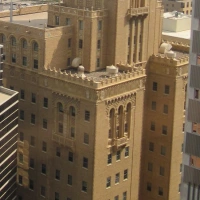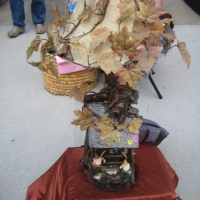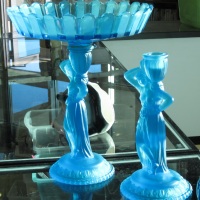We are always on the lookout for the bad and usually find it, as you all know. This post is some of the good stuff that we see, but haven’t bought. If you want to see the good stuff that we buy, you probably need to check out our Etsy stores! Now, this post isn’t totally good; it’s kind of 50/50 because we don’t want to spoil you all. 😉
This is for all the grads out there planning their parties:
We KNOW no one could resist a white unicorn wearing a black mortarboard and gown. The gown even says, “GRAD” so all the nongrads can understand what’s going on here. Not sure why the poor thing has a black and gold tail; unicorns aren’t really known for their love of Vegas bling or flamboyant personalities. And someone should slip the unicorn some minoxidil so at least the mane and tail are full and flowing if they’re going to be humiliated by being dressed up like this.
In the bad old days (my youth), this is what usually followed a graduation:
This is not a baby doll buggy—it’s the real deal. Having said that, it was distressingly low. Kathy and I aren’t tall, but we would have to put some 12 inch wheels on this to be able to push it without hunching over. It was pretty deluxe for its time, with the color and decorative stitching. It even collapses for easy storage. It has been used hard and put away wet. There would have to be some restoration before someone could use this again for anything but display. There used to be a time when baby doll or teddy bear collectors would have snapped this up to display their oodles of goodies. After we saw this, the phrase, “rubber baby buggy bumpers” went through my mind for about two days. Songs aren’t the only earworms! And now that I’ve said that, there is a song with the tongue-twister on YouTube.
Okay, we know why the maker gave up and dropped this off at the thrift store:

Even they couldn’t be sure what the subject was supposed to be. At first I was wondering if it weren’t some iconography from the past? But, looking at it more closely, I think it’s supposed to be a witch. There’s a big ol’ hat, stars, and a moon which seem appropriate. I’m not sure what the leather ties are supposed to be, which kind of makes “witch” a little shaky. Nothing says craft fail like a viewer not even being confident what is being portrayed and the maker giving up.
I really like boxes, all boxes:
I even wrote a post about it, long ago. So, when I see a box I just have to stop, look, and open it up and surprise, there often is something inside:
This really was a surprise and made us both laugh. Who would have expected a whole collection of bears? Even stranger, they were permanent; you couldn’t just pull your favorite bear out and play with it. I just realized that we didn’t look to see if it was a music box. If so, I hope it played “Teddy Bears’ Picnic“.
Gosh, they used to make every day items so pretty and functional:
I’m always a sucker for this form whether it’s a coffee pot or cocktail shaker. It probably even works, or could be repaired; percolators weren’t that complicated. It has its knob and innards so if someone had a yen for perked coffee they were in business. And while not in use, it would look great on your countertop after applying some elbow grease and cleaning it up.
This bag of goodies was back in the crafts:
For the aspiring young Frankensteins out there. I’m not sure there are enough parts to do more than just put the chest together, innards an all:
It was easy to identify the heart, with an aorta, and the lungs. Not so realistic were the ribs with at least 17 pairs; humans usually have 12 pairs. The rest of it was a little harder to see inside the bag, but should probably include a liver, gallbladder, and maybe an appendix. It sure was an unappetizing color, but if you were using this for Halloween, that is a bonus. Honestly, it was kind of an odd collection of pieces and parts.
Last up:
This is such a fun pattern, and a whole table with it would look great! The pattern is “Whirl” by Royal M Meito, Japan. It’s really fine quality and provides another option for those not enraptured by flowers, gilding, fruit, etc. The 1950s sure had some surprising decorating ideas for being so uptight in other ways.
Hope you all have a great weekend, and find some good garage sales, thrift shops, antique malls, or whatever you like to do for fun. Take it from Aunt Deb: it doesn’t have to be work, work, work all the time!






































































































